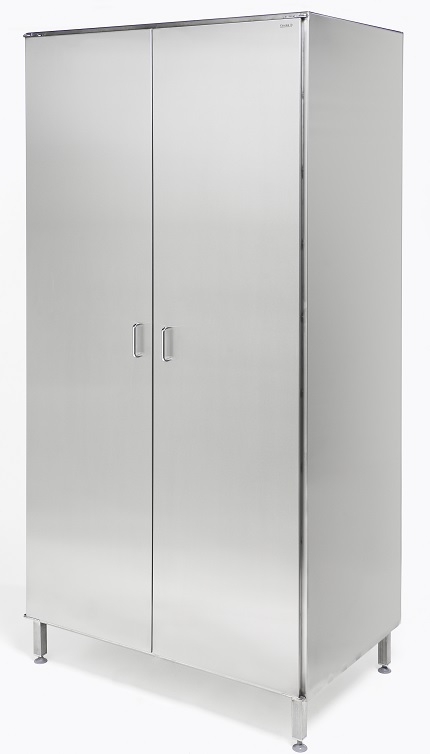It is advisable to check the dimensions of the cabinet (width x depth x height) and the type and number of shelf plates or other necessary fixtures and accessories, if any, when placing the order. For cabinets with one door, the handedness of the door should also be checked.
Floor cabinet 5090
Stainless steel floor cabinets are made in one or two-door configurations depending on the width and intended use of the cabinet. From our range of cabinets, you can put together a set of cabinets that suits your specific needs.
The floor cabinet can be equipped with a suitable number of incrementally adjustable intermediate shelves or other accessories required by the customer.
Floor cabinets are also available with lockable doors where required. The steels doors on all of the cabinets we manufacture have a two-layer structure. The leg pipes are equipped with adjustment pads to facilitate the levelling of the cabinet.

Further information
The cabinets are made in 1 and 2-door configurations with standard dimensioning. The doors of the cabinets have a two-layer structure that makes them robust and durable.
CLEANING
Stainless steel equipment and fixtures must be cleaned on a regular basis to prevent them from rusting. A water wash is often sufficient for cleaning a stainless steel surface; hot water and steam can be used in special cases.
Impurities and deposits that have adhered to the surface can be removed by rubbing them with an emery cloth, for example. NOTE! The emery cloth must be non-ferrous. It is advisable to first try the treatment on a less noticeable part of the product.
DETERGENTS
Standard cleaning powders or power detergents such as soda, borax or sodium perborate can be used for cleaning stainless steel surfaces.
Alkaline solutions, such as soda, ammonia and diluted soda lye, can be used for dissolving grease. Acetone, petrol, alcohol and similar organic solvents can also be used for removing grease deposits or other water-insoluble matter.
Detergents that contain sulphuric or hydrochloric acid may not be used for cleaning stainless steel surfaces.
DISINFECTION
The sterilising agents used for disinfection often contain sodium hypochlorite or potassium hypochlorite. However, these substances are dangerous to stainless steel as they easily give rise to pitting corrosion. Other disinfectants that contain chlorine, such as chloramines, are also dangerous. The most affordable disinfectant that is suitable for stainless steel is nitric acid; even mild concentration solutions have a bactericidal effect.
TREATMENT AFTER CLEANING
The detergent must be carefully cleaned from the steel surface. Rinsing with plenty of water is usually sufficient for this purpose. If acidic detergents are used, a pre-rinse should be carried out with a neutralising solution, such as soda.
The user must always ensure that the room concerned is sufficiently ventilated, proper protective gear is used and any in-house occupational heath and safety instructions are complied with.